RBA Annual Conference – 2006 Population Ageing, the Structure of Financial Markets and Policy Implications W Todd Groome, Nicolas Blancher, Parmeshwar Ramlogan and Oksana Khadarina[1]
This paper will address four issues regarding population ageing and financial markets: (i) the nature and size of the financial challenges facing ageing societies today; (ii) the actions currently being taken or proposed to deal with these challenges; (iii) the potential role of financial markets and existing financial structures in addressing these challenges; and (iv) the role of governments, as managers of key long-term risks related to ageing. These issues are discussed in turn below. The paper draws on research and policy work conducted by staff of the International Monetary Fund, including as published in several chapters of the IMF's Global Financial Stability Report (GFSR), a semi-annual publication that focuses on global financial market developments, particularly the evaluation of structural influences on financial stability, and in a report prepared at the request of the Deputies of the Group of Ten.[2] Related research currently focuses on the limits of market-based risk transfer and the management of long-term systemic risks, including those associated with ageing.
1. The Financial Challenges of Population Ageing
G-20 countries are confronted with a variety of challenges associated with population ageing, reflecting in part two long-term demographic trends: increasing longevity, reflected in rising life expectancy at age 65 (Figure 1); and low and declining fertility rates (Figure 2). A direct implication of these two trends is the continued increase in the old-age dependency ratio – the ratio of pensioners to the working-age population. This ratio currently varies from approximately 10 per cent to about 30 per cent among G-20 countries, and is projected to increase rapidly based on current trends (Figure 3). As such, the demand for retirement income relative to contributions from the working population will be proportionately greater.[3]
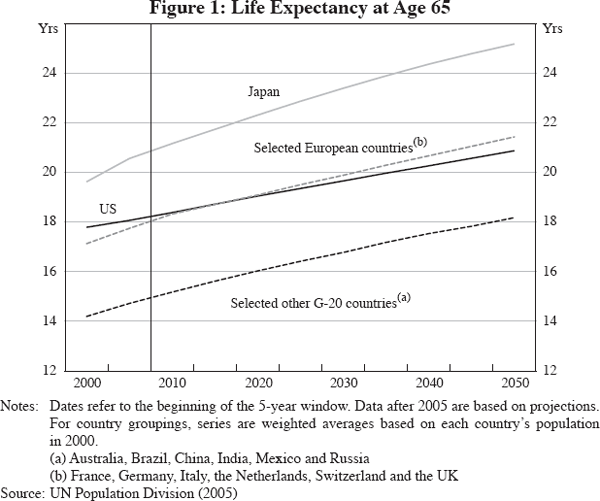
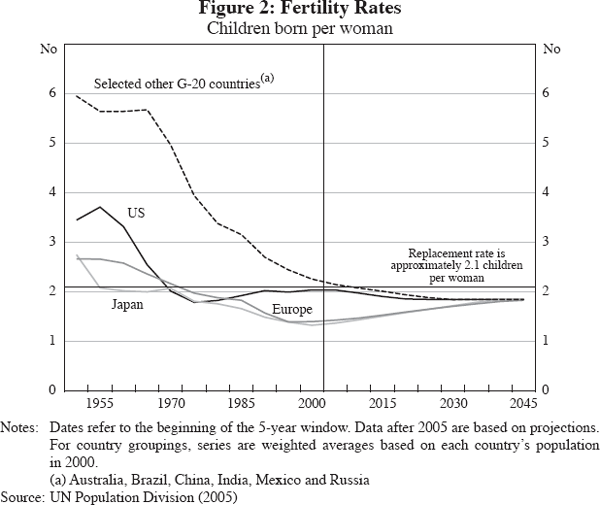
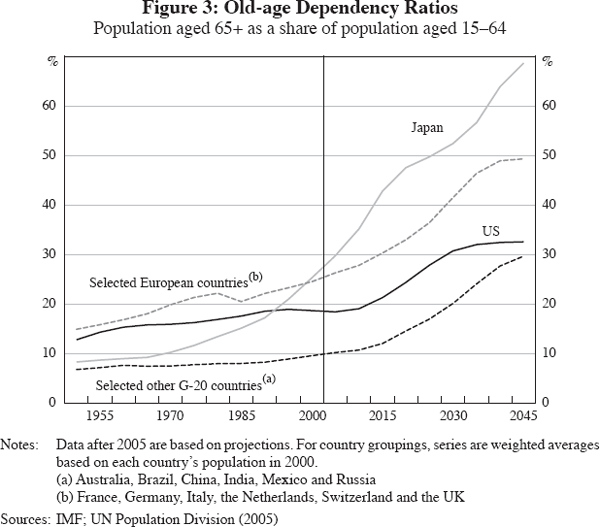
Two broad consequences follow from these trends in population ageing. First, as individuals spend a longer time in old age and retirement, their retirement consumption needs will be greater, in large part because the period of time spent in retirement is increasing, but also because of rising health care expenditures, given the relatively strong correlation between age and spending on health care (see Kotlikoff and Hagist 2005). Consequently, individuals' retirement (replacement) income needs relative to lifetime income will grow, unless individuals extend their working lives. Thus individuals may need to increase their savings to maintain their retirement incomes at adequate levels. Second, ageing and related pressures also highlight the importance of improving the quality of retirement savings, especially in order to better manage risks associated with longevity, investment and inflation, as well as the high and rapidly escalating health care costs in many G-20 countries. In particular, given the ongoing switch from defined benefit to defined contribution and similar pension plans, households will need to ensure that they are appropriately managing these long-term risks and financial obligations.
1.1 Increasing and improving retirement saving
A major component of retirement saving is pension saving. As populations age, the relative size of pension fund liabilities grows, with the total ‘theoretical’ level potentially dwarfing levels recognised thus far (Figure 4). Moreover, the growth in liabilities may be greater than expected, as increases in longevity have consistently exceeded actuarial forecasts. Therefore, the challenge of managing and maintaining adequate savings levels by the public, private (i.e., corporate) and household sectors has become more urgent.
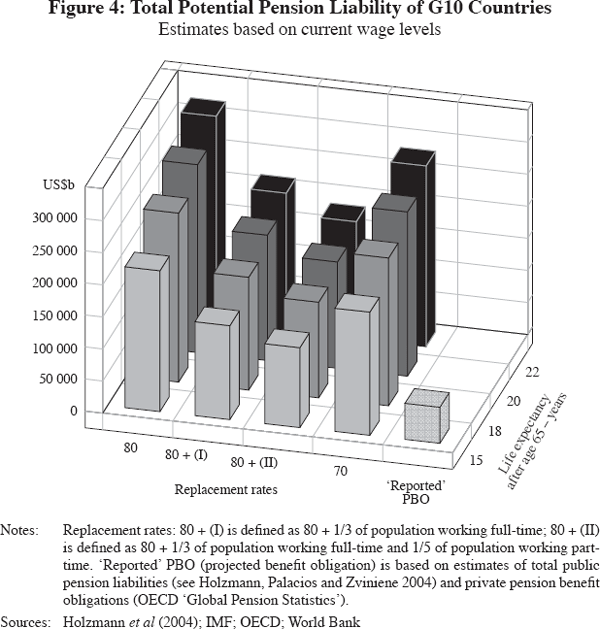
The impact of population ageing on defined benefit pension plans has been compounded since 2000 by lower equity market returns and (importantly) low interest rates, which have significantly affected pension funds' asset and liability valuations. Equities remain a large component of the asset portfolios of pension funds in many countries (Figure 5), but the effect of lower interest rates on funding ratios may have been at least as large as that related to lower market returns (Figure 6). Reflecting the above factors, many defined benefit pension plans have become significantly under-funded since 2000 (Figure 7), although funding ratios appear to have recovered somewhat in the past two years. This is true in both industrial and non-industrial countries.
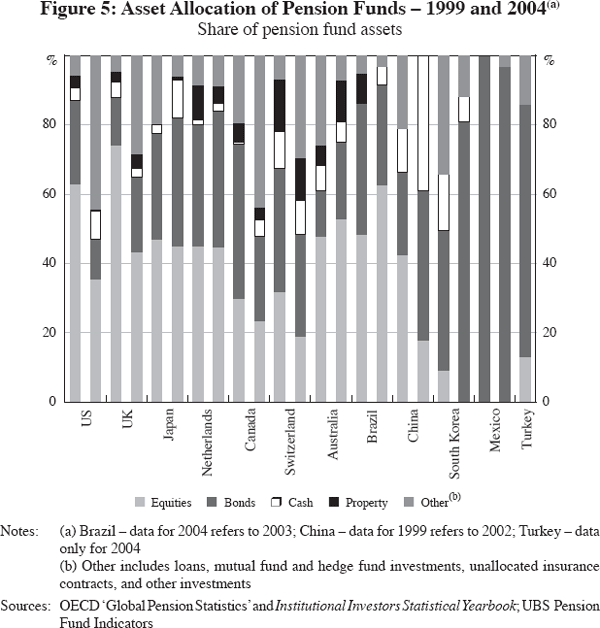
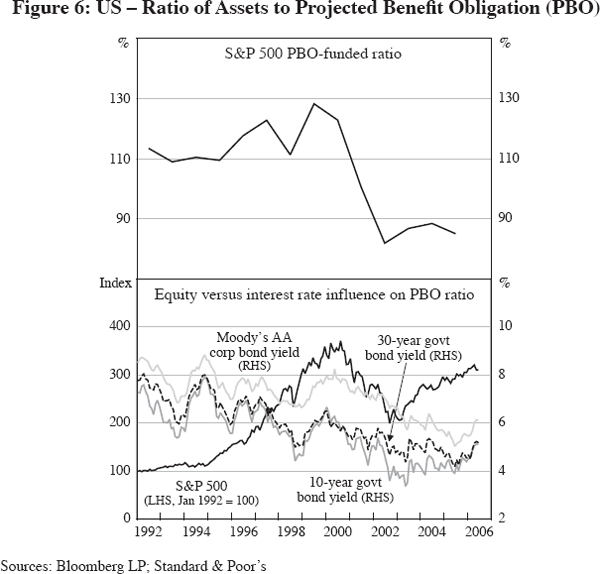
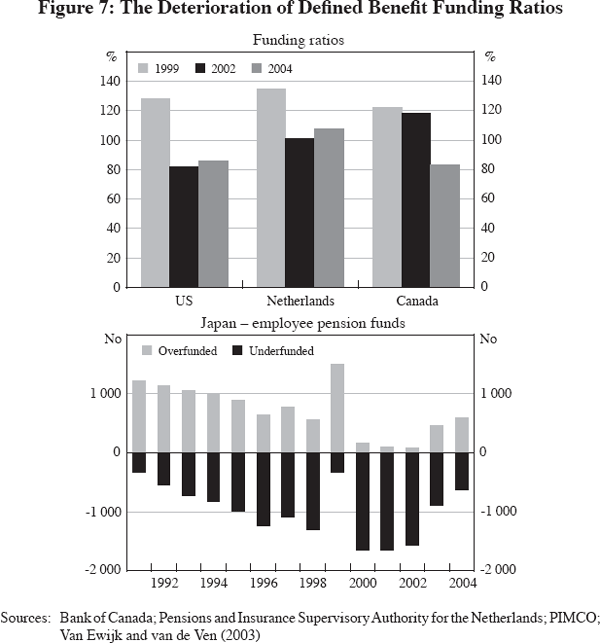
The growing pressure on both public and private defined benefit pension plans in these countries may lead to lower replacement rates, and has accelerated the trend toward defined contribution and hybrid plans in the United States, Europe and Japan.[4] Contribution rates in defined contribution plans tend to be lower; and where participation in such plans is voluntary, the experience of many countries is that participation rates tend to be low. Both of these factors adversely affect retirement saving.
There remains concern in some countries that households may not be adjusting their saving levels to achieve expected replacement rates. In the United Kingdom, the 2006 Pensions Commission Report warned that many households are significantly undersaving (Pensions Commission 2006). In the US, a newly-developed national retirement risk index shows that almost 45 per cent of working-age households are at risk of having inadequate retirement income (see Munnell, Webb and Delorme 2006). Of particular concern may be the impact on middle-income and middle-age cohorts. Unlike low-income and high-income individuals, who benefit from safety nets and private savings, respectively, this group tends to rely disproportionately on traditional private and public benefit schemes, which are already in decline (Figure 8). In countries where public programs (such as health care and education) are more extensive, the adequacy of household saving has not been a major source of concern to date. However, ageing-related fiscal pressures in these countries have also increased the focus on the need to encourage greater private savings, and the development or deepening of Pillar 2 and Pillar 3 pension systems is increasingly important.[5]
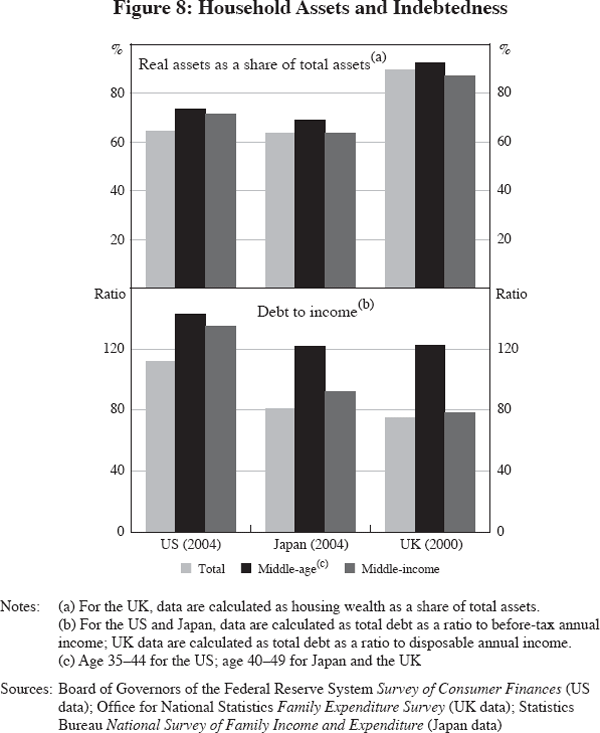
1.2 Managing long-term financial risks
There is likely to be growing attention on the capacity of governments, pension funds and households to not only save more for retirement and ageing needs, but also manage key ageing-related risks. In essence, this involves a reconsideration of existing risk-sharing arrangements. Such risks include: (i) market risks (i.e., interest rate, equity and credit risks, as well as derivatives embedded in structured products); (ii) inflation risk (as governments and corporates adjust or eliminate benefit indexation); (iii) investment planning and reinvestment risk (i.e., operational risk); and (iv) longevity risk (as public and private annuity income streams are reduced or eliminated).
The ongoing shift from defined benefit to defined contribution pension plans is a major channel for the transfer of risks to households. This trend is more prevalent in some countries, notably the UK and the US, but also increasingly in other G-20 countries. In the UK, for example, active membership of open defined benefit schemes is estimated to have fallen by 60 per cent since 1995, and only 15 per cent of new private sector employees are members of salary-related schemes. Among other G-20 countries, India, China and South Korea have recently introduced defined contribution pension systems, while in 1997 Mexico replaced its national pay-as-you-go (PAYG) pension plan for private sector workers with a fully-funded system. The increase in household exposure to a variety of new risks is greater in such countries, since self-managed plans require more individual decision-making, and do not normally provide (or require) annuity or similar payout features. As such, a sufficiently broad range of saving, investment and payout products are likely to be needed to expand households' saving and investment opportunities, and to enable households to appropriately diversify and manage their risks.
Population ageing also exposes households, private insurers and governments to substantial health care risks, given the correlation between age and spending on health care. Health care costs have risen well in excess of household incomes and general inflation in many G-20 countries. For example, total health care spending in OECD countries rose from 8.6 per cent of GDP in 1990 to 10.9 per cent of GDP in 2003, and public sector spending on health care has increased at an even faster pace in some countries. Advances in medical technology account for about 90 per cent of the increase in health care spending over the past three decades, while population ageing explains the rest (see Kotlikoff and Hagist 2005). Rising health care costs may prove a significant burden for households. Given budgetary pressures in many countries, similar to pensions, public sector subsidies for health care and long-term care may decline in the future, or new ‘sharing’ arrangements for such costs and risks may be proposed.
A challenge for authorities will be to influence how households manage their long-term financial obligations and risks, which are becoming larger and more complex. Developing and executing long-term saving and investment plans are skills that many individuals may find very difficult without expert advice and assistance. As a first step, households' awareness of the challenges that face them needs to be increased. This requires more communication by authorities, and greater financial education of most individuals.
From the government's perspective, the increasing financial pressures on pension plans and health care provision pose substantial long-term risks. Ageing-related costs represent latent but unavoidable liabilities of the state, associated with its role as employer and provider of public social services to the population, which often may not fully be accounted for. Furthermore, the responsibilities of the state may go beyond its explicit commitments, and encompass a role as the ‘insurer of last resort’. This is a source of additional and possibly significant implicit contingent liabilities.
Over the coming decades, the projection of current trends is likely to result in a dramatic increase, relative to GDP, in the share of public expenditure related to population ageing (i.e., pension, health care and long-term care), fuelled primarily by the rise of health care and long-term care expenditures. Absent further reforms, spending reductions elsewhere or changes in the distribution of risks, the implications of ageing and related government liabilities have the potential to provide ‘intense pressure’ on public finances. As highlighted by several researchers, the resulting fiscal implications could significantly undermine the credit standing and sovereign ratings of many countries (Table 1). Moreover, as one considers this analysis closely, there is considerable uncertainty regarding the estimates and extent of these ageing-related liabilities. Longevity and health care costs are influenced by a large number of variables that are difficult to model and predict. Nevertheless, scenario analysis undertaken by different researchers to control for some of the key variables indicate that the projection of rapid growth of pension, health care and long-term care spending, including as a significant and rising percentage of GDP, is a robust one.
| 2005 | 2020 | 2030 | 2040 | |
|---|---|---|---|---|
| Australia | AAA | AA | BBB | Non-IG |
| Canada | AAA | AAA | AAA | AA |
| France | AAA | A | Non-IG | Non-IG |
| Germany | AAA | AAA | A | Non-IG |
| Italy | AA | A | Non-IG | Non-IG |
| Japan | AA | Non-IG | Non-IG | Non-IG |
| South Korea | A | A | Non-IG | Non-IG |
| Spain | AAA | AAA | BBB | Non-IG |
| Sweden | AAA | AAA | A | Non-IG |
| UK | AAA | AAA | A | Non-IG |
| US | AAA | BBB | Non-IG | Non-IG |
|
Note: Non-IG = non-investment grade Source: Standard & Poor's (2006) |
||||
2. Current Efforts to Address the Challenges
In seeking to address the above challenges, countries are generally following three broad avenues. First, some countries have taken, or are considering, steps to strengthen the financial position of pension plans, including Pillar 1 pension plans, and public health care systems. In particular, and most effectively, they have sought to influence the risk management behaviour of pension fund managers in some countries through changes in financial regulation and supervision, accounting standards and taxation. Second, some governments have started to give greater priority to increasing the ability of households to manage financial risk through financial education. Finally, to complement actions in the above areas, several governments have sought to encourage the development of new financial markets and instruments to provide pension funds, insurance companies, households, and possibly the public sector, with better tools to manage these important long-term risks. This section looks at the actions being taken in the first two areas. The development of financial markets is examined in Section 3.
2.1 Reform of public pension and health care systems
In recent years, many governments have implemented reforms to make public pension and health care systems more sustainable. In the case of pensions, such reforms have primarily focused on changing key state pension parameters, including contribution rates and periods, benefit indexation, statutory retirement age and incentives for early retirement. Recent reform proposals by the UK Government are a good illustration of such reforms, and contribute significantly to the ongoing debate in Europe and elsewhere about the need to reform state pension systems to cope with the rising cost of rapidly ageing populations, and to tackle the problem of undersaving for retirement, while seeking to clarify the respective roles of the State, the employer and the individual in this respect.
Governments have also moved to reduce or better control the high and rising cost of health care. In Europe, some governments have cut back on publicly provided benefits, and private health insurance is increasingly being used to supplement state-funded health care systems. Steps have also been taken to introduce greater competition in the health care industry. For example, in 2006 the Netherlands introduced compulsory health insurance, which is now being supplied by private insurers who compete for customers through the flat-rate premiums they charge.[6] In the US, where employment-based private health insurance is predominant among the non-elderly, the introduction of managed care in the 1980s (under which insurers establish contractual arrangements with health care providers and exercise greater surveillance over costs and practices) has helped to control costs. The Japanese Government is currently debating reforms to contain health care costs and achieve a more sustainable public health care system, including disease prevention measures, shortening hospital stays, and increased co-payments.
An increasing number of countries account more explicitly for ageing-related liabilities, including health care liabilities, in their long-term fiscal framework. Some countries, such as China, France, Ireland, Japan and the Netherlands have also set up reserve funds aimed at better securing the financing of public pension liabilities, including through investments in financial instruments. However, in many countries, further efforts will be necessary to put state pension and welfare systems on a sustainable path. Unless social security and welfare benefits are brought under control, many G-20 governments will face stark options in the medium term, such as significant cuts in other government programs or large tax increases, or both.
2.2 Regulatory and supervisory frameworks
In many countries, pension regulations have rarely encouraged a focus on financial risk management, emphasising instead pensioner and employee rights. Regulators have traditionally influenced solvency or prudential considerations through minimum funding requirements, restrictions or limits on certain types of investments, or ‘prudent person’ rules (which generally establish a principle of diligence that a prudent person acting in a like capacity would use). However, these initiatives do not deal explicitly with the risk inherent in a pension fund's balance sheet, and pension fund investment and risk management practices have often focused more on asset returns than addressing the actual liability structure of the pension balance sheet.
Recent regulatory (and accounting) changes have put more focus on risk management. The Dutch authorities have led the way in encouraging a more rigorous asset-liability management focus by pension funds, with the introduction of a new risk-based approach to supervision, expected to be fully implemented in early 2007. The new framework seeks to ensure that pension funds remain fully funded at almost all times. Important elements of this new framework are the reliance on fair-value measures and advanced risk modelling techniques (including, where appropriate, pension funds' own risk models), and the use of market interest rates as a discount factor for pension liabilities (across the market yield curve and liability profile of the pension fund). In particular, a ‘solvency test’ introduces an innovative risk-based capital framework requiring pension funds to maintain at least a 105 per cent funding ratio under most circumstances, while a ‘continuity’ analysis requires them to project their financial position over 15 years, reflecting various long-term scenarios (i.e., a sensitivity analysis).
Similar moves toward more risk-based regulatory frameworks are also evident in the UK and the US, where market-based discount factors have been introduced, and where the use of risk-based premiums for payments to pension guarantee funds (e.g., the US Pension Benefit Guaranty Corporation or the UK Pensions Protection Fund) are being considered, including having such premiums reflect a pension fund's risk profile or asset-liability mix. The choice of the discount rate for minimum funding requirements increasingly influences pension fund asset allocation and investment strategies. As such, pension fund managers wishing to limit the volatility of their funding ratios (and the sponsor company's obligations) may hold a larger allocation of assets with a higher correlation to the discount rate used to measure liabilities. Historically, in many countries the regulatory discount rate was fixed, or only adjusted periodically. More recently, there has been a shift toward greater use of market-based discount rates. In the UK, for example, discount rates based on AA-rated corporate bond yields were introduced in 2001, and produced a greater demand for corporate bonds in recent years.
2.3 Accounting standards
Following recent and ongoing changes in international accounting standards, as part of the International Financial Reporting Standards and market-based, fair-value accounting principles, listed firms must incorporate pension liabilities in their financial statements, so as to provide greater disclosure of a pension fund's financial condition and obligations. The use of fair-value accounting principles addresses the arbitrariness of certain traditional pension fund accounting practices, which tended to smooth pension returns over several periods in the financial accounts of sponsor companies. It has been recognised that such smoothing mechanisms introduce arbitrary and inconsistent accounting and reporting standards, contributing to poor risk management practices and limiting the usefulness of financial reports. In particular, the use of subjective assumptions and projections (e.g., regarding asset returns), which frequently vary between companies, may hamper comparative analysis, and the financial risks borne by the sponsor companies may be understated.
However, by generating greater volatility in sponsor companies' balance sheets, fair-value accounting may also have unintended consequences, especially with regard to a pension fund's investment behaviour. Recent experience in the UK, but also in other countries such as Japan and the US, indicates that fair-value principles may accelerate moves from defined benefit to defined contribution and hybrid plans, as companies seek to ‘de-risk’ their pension obligations and transfer investment and market risks to employees/beneficiaries. Importantly, from a financial stability perspective, greater sensitivity to accounting volatility may also encourage sponsor companies and fund managers to focus on short-term investment strategies, or seek to reduce accounting volatility by reallocating their portfolios from equities to bonds (or related derivative strategies). As such, accounting changes may raise the risk that pension funds act in a more procyclical fashion while the longer-dated nature of their liabilities has historically allowed them to act as long-term, stable sources of capital, demonstrating essentially acyclical investment behaviour, which benefited financial stability.
2.4 Tax policy
In many cases, tax rules on pension contributions have been used to effectively set upper and lower bounds for funding decisions. This is the case in the US, where contributions that would increase the funding level beyond a 100 per cent funding ratio are not tax deductible, and may even attract an additional 10 per cent tax. Taxation and other rules can create disincentives or prohibitions to annual contributions, or the withdrawal of surplus assets, thereby further discouraging precautionary overfunding. In addition, the loss of tax deductibility for interest payments on long-term bonds (e.g., those with a maturity greater than 30 years) has worked to limit the supply of such securities, which would benefit pension fund risk management efforts.
Tax rules also influence how individuals save. Tax incentives are generally designed to give preferential treatment to retirement savings. Indeed, the fiscal cost of tax incentives for retirement savings may be viewed as preventative of potentially much larger costs that may otherwise be incurred later to support people with inadequate retirement savings. It remains unclear, however, whether tax incentives help raise overall retirement savings, or merely shift existing savings. Empirical evidence is mixed, but an OECD survey found that about 60 to 75 per cent of savings in tax-favoured vehicles represents a reallocation from other savings (OECD 2004). However, even such a reallocation of savings may be beneficial from a retirement planning perspective, if it represents a shift from short-term to longer-term and more stable and committed savings.
2.5 Financial education of households
Improved household financial literacy should be seen as an integral part of efforts to improve financial and macroprudential stability. Indeed, if households are unable to manage the above growing challenges, governments may come under pressure to support the household sector directly or to re-regulate certain products or services. Furthermore, raising household financial literacy should enhance the efficiency of financial intermediation, and encourage the development of products that are better-tailored to the saving needs of individuals.
The design of financial education programs is attracting increasing international attention. The OECD has recently completed a cross-country Financial Education Project aimed at identifying international good practices for financial education programs, in particular with respect to their focus, their delivery channels, and their relative effectiveness. Overall, more efforts are needed by governments to help improve household financial behaviour, including by strengthening basic financial education programs in schools, by designing fiscal and regulatory frameworks that motivate households to save more and to better invest their savings, and by encouraging financial advisers to provide long-term planning advice. To complement this, the private sector is well-positioned to deliver targeted financial education and advice to households. Indeed, in many countries, employer-sponsored seminars have had a positive impact on employee participation rates in occupational pension plans, and financial institutions increasingly realise that it is in their own interest to provide households with better educational tools and sound advice on financial decisions.
3. The Potential Role of Financial Markets
A variety of financial instruments are required to meet the challenges of raising long-term saving and investment, and managing long-term risks and obligations. However, many of these instruments, and their related markets, remain underdeveloped or non-existent. Markets that facilitate the transfer of ‘alternative’ risks (or their components) via the capital markets lag financial developments that enable the transfer of interest rate, foreign exchange and credit risk, and relatively little market-based alternative risk transfer is taking place today. Moreover, within alternative risk transfer markets, innovations to transfer or hedge exposures to longevity- and health care-related risks have proved especially difficult.[7]
This section looks at governments' efforts to deepen existing markets and to create new markets that may better meet the needs of households and institutional investors. The government's role may vary from country to country, as the level of financial sector development, and therefore the capacity of financial markets to respond to the challenges of population ageing, varies greatly across G-20 countries. In countries where capital markets are under-developed, it is often difficult to find long-term instruments to satisfy the saving/investment and risk management needs of households and institutional investors. Even among G10 countries, the relative availability of products varies significantly.
3.1 Development of existing markets
Pension fund managers routinely stress that new instruments and a greater supply of certain existing securities are needed to help them better manage duration, longevity and inflation risks. The availability of such instruments would complement the introduction of more market-oriented or risk-based regulatory frameworks that, as noted, encourage a greater focus on asset-liability management. These instruments include long-dated (30 years and longer) and inflation-linked bonds. By facilitating hedges against duration, longevity and inflation risk, such instruments may also encourage insurance (and reinsurance) companies to increase the supply of annuity products for individuals.
In many countries, authorities have sought to further develop longer-dated bond markets, which remain small relative to the potential demand of pension funds and insurance companies (Figure 9). While the market for long-dated bonds is deepest in the US, even there the size of the market for maturities beyond 10 years is relatively modest. In 2005, a few European countries started issuing very long-dated bonds. Corporate issuers desiring longer-term funding also exist in most mature markets (e.g., capital-intensive industries, utilities, and financial institutions). However, corporate issuance of long-dated bonds is limited and may be hampered by a variety of factors, including the lack of publicly traded benchmarks, tax disincentives in some countries for very long-dated issuance (e.g., beyond 30 years), as well as more cyclical factors, such as the strong liquidity of many corporate balance sheets worldwide and the low cost of shorter-term credit in recent years.
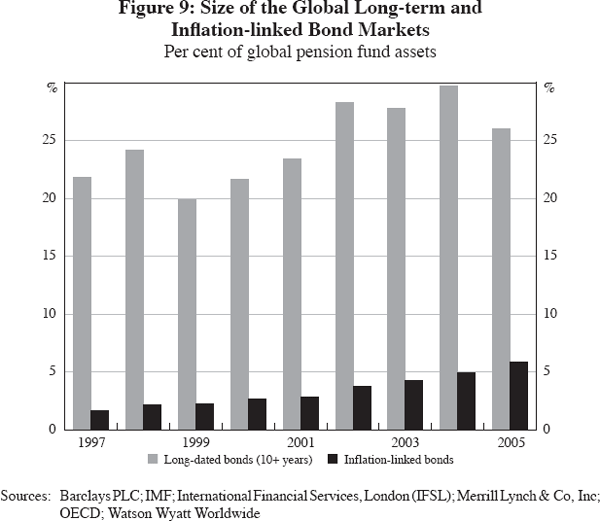
As with long-dated bonds, the market for inflation-linked bonds (ILBs) remains small relative to potential demand (Figure 9). Several countries, including Argentina, Brazil and Mexico, issued ILBs in the period 1945–1980. However, the modern ILB market began in 1981 with more substantial issues by the UK Government. Today, several G-20 countries in addition to the UK have issued ILBs: the Australian Government began in 1985;[8] the Canadian Government since the early 1990s; the US Treasury since the late 1990s; and the Japanese Government since 2004; and other countries, such as Germany, have recently announced their intention to issue. In the US, the largest ILB market, the nominal amount outstanding exceeded US$360 billion as of May 2006, against about US$220 billion in the UK and US$141 billion in France. Nevertheless, if the potential demand for long-dated bonds and ILBs from pension funds and insurers materialised (e.g., due to regulatory and accounting pressures), such demand would overwhelm existing supply, and may materially contribute to flatter market yield curves.
The availability of a variety of retail products, ranging from saving and investment to payout instruments, and broader liability management products, is increasingly important for individuals and households, and in recent years there has been growth and diversification in the range of investment products available to individuals for retirement. Regarding the investment phase, ‘life-cycle’ products have been developed to address certain ‘operational risks’, such as the perceived need to reallocate or rebalance portfolios in line with individuals' theoretical reduced risk tolerance as they age. In some countries, structured products also offer a variety of risk/return profiles, including capital or performance guarantees. Going forward, retail investment products that provide access to additional asset classes (e.g., hedge funds, commodities, or real estate) may also be sought as, similar to pension funds and other investors, households may seek investments that provide diversification and correlation benefits.
A crucial element of household retirement planning is the ability to convert long-term savings into a dependable income stream during retirement (i.e., annuitisation). Increasingly, academics and policy-makers are concluding that an individual's greatest retirement risk may be that of outliving his or her retirement assets (i.e., longevity risk). However, annuity markets are generally underdeveloped (or at least underutilised), particularly for individuals, and in several countries the number of institutions providing annuity products has declined in recent years.
Housing assets generally make up a large share of household net worth (Figure 10). The availability of home equity release products, such as reverse mortgages, may help households to realise this form of long-term saving and obtain an annuity-like income stream. More generally, since housing is for households both a major savings vehicle and a currently consumed asset, financial instruments that support these two functions may have an important role to play. In particular, instruments that provide hedges against house price movements may facilitate residential real estate investment for existing homeowners (and institutions) and prospective purchasers, thereby potentially enhancing market liquidity. In May 2006, indices of house prices in 10 US cities started trading on the Chicago Mercantile Exchange.[9] Some countries (including France, Germany, Hong Kong SAR, Japan, and the UK) also have developed, or are looking to develop, broader real estate products, including more conventional real estate investment trusts for a variety of property types.
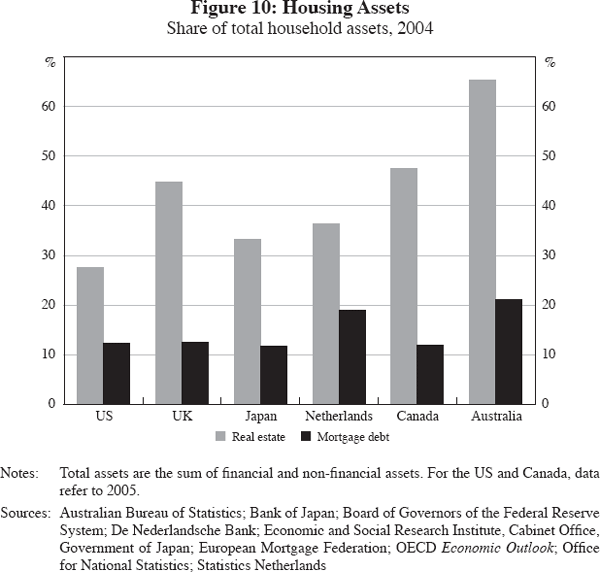
3.2 Efforts to develop new markets
New products and markets, including risk transfer markets, may need to be developed to expand the range of long-term saving/investment and risk management instruments available to institutions and households. These include, among others, markets to manage longevity, health care costs, and house price risks, all of which are important in the context of ageing populations.
3.2.1 Longevity risk
Annuities provide a longevity risk hedge for consumers, and longevity bonds could do the same for insurance companies and pension providers. However, the development of the annuities market has been hindered in part by the limited availability of suitable long-term hedges, including against inflation risk, as well as by lacklustre consumer demand, reflecting the insufficient focus on long-term risk management and perceived cost considerations. A particular problem is the uncertainty related to longevity estimates (e.g., medical developments), which introduces risks that may not be diversifiable. The European Investment Bank (EIB) tried to meet the demand for longevity hedging instruments in 2004/05 with an offering of longevity bonds, which was eventually withdrawn. The failure of the issue was attributed to several design flaws, including a somewhat narrowly defined underlying index (based on 65-year old English and Welsh males), and (more importantly) its 25-year maturity, which left extreme longevity (i.e., life beyond 90 years) uncovered.[10]
3.2.2 Health care coverage and costs
Reinsurance is used to a very limited extent to manage health care coverage and costs, and there is no capital market activity for health care-related risks. A major factor is the large number of variables that affect health care costs and spending, which are inherently difficult to model and predict. This difficulty is compounded in some countries by the fragmented and local nature of the health care delivery system, which makes it more difficult to produce comparable health care data on a broad geographical basis. Private insurers and the government – a major player in the health care market – manage these risks largely by shifting them to households and/or plan sponsors, primarily through repricing mechanisms (usually annual) or, in the case of the government, increases in taxation and/or reductions in benefits. The ability to reprice such coverage and risks is frequently cited as the primary risk management tool for health care provision, and the reason reinsurance is rarely utilised.
3.2.3 House price risk
Housing wealth is a growing and increasingly important source of retirement income in Europe, the US and a number of other developed economies. Declines in house prices could therefore have a significant impact on individuals' retirement consumption, making the ability to hedge price movements increasingly relevant. As noted above, house price indices started trading very recently in the US, but the market to hedge house price risk remains nascent or non-existent elsewhere.
3.2.4 Market structure and innovation
In some G-20 countries, capital markets are less developed, and the range of saving and investment instruments available to households and institutional investors may be limited. For example, pension funds in some countries (e,g., China, Mexico and Turkey) are invested largely in domestic government bonds and short-term investments (see Figure 5). The further development of capital markets in these countries – including credit markets – would introduce opportunities for greater portfolio diversification while improving the risk-return profile of households and institutional investors. Moreover, further capital market development and diversification opportunities are also important for the development of broader risk management instruments and risk transfer markets.
In many G-20 countries, market development may be hampered by a variety of structural and institutional impediments, including limitations on international investment flows. In the case of risk transfer markets, traditional techniques for the ‘true sale’ of assets, such as loans, encounter numerous legal and institutional frictions in many countries which may prevent banks from transferring risks through direct or cash securitisations. Such frictions typically include transfer taxes, inadequate or inconsistent loan documentation, requirements relating to borrowers' consent, uncertainties regarding the bankruptcy status of special purpose vehicles and often other legal uncertainties. Additional frictions in some emerging-market and developing economies, such as those in Asia and the Middle East, include conflicting or incomplete local regulations and standards (e.g., creditors' rights and bankruptcy proceedings). As a result, in a number of countries synthetic credit risk transfer structures have developed, and have been instrumental in overcoming many of these frictions. Indeed, much of the credit risk transfer activity in Europe has been achieved synthetically, in part because of market structure factors, such as less complete bond markets, but also in response to some of the frictions noted above.
Regulation, technology (including risk modelling) and data quality and availability are very important influences on market development and innovation. In industrial economies, market participants and academics believe that the technology and financial skills necessary to realise deeper and more complete markets, including new risk transfer markets, are currently available. However, they also frequently state that policy-makers and regulators must attempt to provide more consistent and stable supervisory and prudential frameworks, in order to encourage or allow market participants to pursue the longer-term investments needed to achieve some of the risk management objectives discussed in this paper. For example, the Basel regulations since the late 1980s have encouraged banks to sell credit risk and create more liquid balance sheets, and technology has evolved allowing banks to evaluate and differentiate credit-related risks more precisely, which has enabled them to tailor securitisations to meet ever more specific investor demands. Similar regulatory vision or influences may be required to encourage the development of risk transfer markets in the insurance and pension sectors, since many of the products to manage ageing-related risks have an insurance or pension component. The forthcoming Solvency II principles in Europe may be important in this regard, and may be used to promote new risk management practices and tools in the insurance industry, including greater risk transfer activity.
Through the various policy levers at their disposal – regulation, accounting standards, taxation, and compulsion – governments exercise important influences on the flow of risks, asset allocation decisions and the behaviour of market participants. This ability to influence market developments differs from country to country, based on the degree of development of financial markets and institutions. As such, governments may increasingly wish to understand how they may influence and benefit from market practices, including in their role as a risk manager. These issues are explored in Section 4.
4. The Government as Risk Manager
As outlined above, the economic and financial challenges associated with population ageing have continued to grow. Ongoing reforms of pension and other benefit systems have increased public awareness of these issues in some countries, and reforms are increasingly being debated among policy-makers. In the UK, in particular, the debate has progressed significantly in the last 12 months, based on the work of the Pensions Commission.
Increasing public awareness and debate is important, but only a first step. Government should increasingly approach these issues as a risk manager, particularly due to the long-term and systemic nature of many of the risks associated with ageing. In doing so, authorities should also consider various market solutions and inputs as they evaluate the costs and benefits of different policy options. In this regard, governments may consider three broad, possibly complementary, approaches: (i) the use of various policy levers noted above to encourage the private sector to address incomplete markets for the management of ageing-related risks; (ii) to act as the ‘insurer of last resort’, and directly assume (perhaps temporarily) some of these risks; and/or (iii) to determine that households are best positioned to bear and manage these risks, support efforts to improve financial literacy, and encourage the availability of long-term planning advice and products.
4.1 Encourage the private sector to address incomplete markets
Through the use of the various policy levers described below, governments influence the flow of risks in the financial system, and can encourage the development of new products and risk transfer markets, as occurred with respect to the credit derivative markets during the 1990s. Many observers (particularly insurers) previously believed that credit risk was inherently ‘untransferable’ or ‘untradable’, which has proven not to be the case. Similarly, insurers today believe that certain ageing-related risks reflect ‘one-sided’ markets,[11] where they must price exposures to reflect the cost of capital and reserves required to hold such risk, and the most effective risk management technique is portfolio diversification. As with banking and the Basel guidelines, governments may seek to influence traditional insurance risk management practices and encourage market innovations, particularly with respect to ageing-related risks.
4.1.1 Regulatory frameworks
As noted above, some countries, most notably the Netherlands, have recently made significant strides to strengthen the regulation of pensions, particularly through more risk-based supervision to encourage fund managers to focus more on risk management and asset-liability management. Regarding the management of longevity risk, last year's attempt by the EIB to issue a longevity bond highlighted that post-90-year longevity is particularly difficult to hedge, and represents a significant capital exposure for providers (estimated to be 20–25 per cent of allocated capital). Therefore, efforts to improve supervisory frameworks, including increased risk-based principles and internal modelling, should improve the risk management focus of pension fund and insurance managers. Moreover, such an approach is also likely to encourage the development of new products, which may also alter the allocation of risk between insurers and beneficiaries (e.g., annuity products may be repriced and renewed every 10 years or so to mitigate the uncertainties of modelling longevity beyond 15 or 20 years). As a result, more basic products may emerge, which may also encourage greater demand and use.
4.1.2 Accounting standards
The shift to fair-value accounting principles in many jurisdictions was intended in part to bring more market values and discipline to pension reporting. In general, this seems to be a sensible policy. However, it is not clear that the volatility associated with fair-value accounting measures accurately reflects a pension fund's true risk profile, or properly focuses risk management on these long-term pension obligations. Indeed, an important question is whether full implementation of fair-value accounting may lead pension funds to overly focus on accounting volatility and become more active traders, thereby reducing the traditional long-term investment focus of pension funds (and insurers), which has typically enhanced financial stability. Similarly, policy-makers may also consider whether broader disclosure of the asset and liability structure of pension funds (including the maturity profile of pension obligations, and market and interest rate sensitivities) may provide investors and beneficiaries with more useful information.
4.1.3 Tax policy
In theory, tax policies often seek some form of tax neutrality, in that such policies are not necessarily meant to dictate decision-making. However, as noted earlier, with regard to pensions, taxation is often the determining factor in setting annual contributions. As such, tax regimes for pension funds should be designed to encourage prudent, possibly continuous funding policies, and ideally seek to build reasonable funding cushions (e.g., two or three years of normal contributions). With regard to the household sector, the clarity and stability of tax regimes is deemed essential to encourage the development of adequate long-term savings and investment products. More broadly, tax incentives may also be used to trigger the development of new markets, such as ‘macro swaps’, through which (for instance) the pension fund and health care industries may swap their complementary cash flows and exposure to longevity.[12] Governments may encourage these transactions, for example, by introducing appropriate tax incentives for the health care industry, perhaps conditioned on certain research or product development efforts targeting the needs of the ageing/retiring population.
4.1.4 Data availability
The availability, reliability and timeliness of data required to decompose, price and trade individual risks, are broadly cited as crucial (and often missing) for the development of markets to better manage certain ageing-related risks. Governments may have a comparative advantage and interest in improving the availability of data, which may be seen as a relatively low-cost method to support market-based solutions. For example, market participants cite the absence of comparable health care data, the unreliability and out-of-date nature of mortality information, and the lack of reliable local data on house price movements as reasons these areas have been slow to develop or altogether absent from financial market analysis. The development of liquid housing price index markets would provide savers with opportunities to hedge against price increases (for those saving to buy real estate), and homeowners to hedge potential price declines (e.g., as they approach retirement). Such hedging instruments may facilitate the growth of reverse mortgages or similar equity release products, allowing households to more easily realise an annuity-like income stream, and thus better hedge longevity risk.
4.1.5 Compulsion
The need to pool diversified risks is an important feature of insurance, including annuities and health care coverage. For example, to reduce adverse selection and bias, governments may impose a degree of compulsory annuitisation, possibly as a proportion of tax-privileged pension savings. In the UK, the authorities require that at least 75 per cent of defined contribution or personal pensions be annuitised by age 75. Importantly, mandatory annuitisation may encourage the emergence of more ‘vanilla’ annuity products, and potentially improve households' understanding and acceptance of such products.[13] In the health care sector, compulsory coverage may also be a way for the government to overcome market limitations. For example, many OECD countries have mandatory universal public or private health care.
4.2 Government as insurer of last resort
In some cases, governments may need to act as the ‘insurer of last resort’ to address incomplete markets or to provide solutions where markets may be unable. This role is already recognised in areas where risks (or related costs) are deemed too great or undiversifiable for the market to effectively insure. For example, the government's role in providing bank deposit insurance has been seen in some countries as a cost-efficient way to promote the stability of the banking system, and pension guarantee funds, backed ultimately by the government, are present in several countries.[14] Continuing with the consideration of longevity risk, which most insurers describe as unhedgeable, governments may consider assuming a limited (but important) portion of longevity exposure, such as extreme longevity risk, possibly defined as persons over age 90. In this way, by assuming the costly tail risk, governments may increase the capacity of pension and insurance industries to supply annuity protection to employees and households, and facilitate the broader development of longevity risk markets.
When considering the government as an insurer of last resort for ageing-related risks, an important consideration is the extent of state pension provision under Pillar 1. For example, if the state provides a substantial public pension benefit, such existing exposure may limit the scope for the state to take on greater risk. Conversely, where state plans represent more of a safety net (and not a retirement-style pension), or as the level of state pension is reduced in some countries, governments may ‘free up capacity’ to absorb certain ageing-related risks, ideally in a manner which may also attract private capital and capacity.
In all cases, government interventions should be part of a comprehensive strategy, taking into account expected costs and benefits (i.e., the impact on the public sector balance sheet), the time horizon, and the existence of potential financial market solutions. In this regard, government interventions may be tailored to very specific risks or of limited duration, and removed as private financial services develop. For example, in the area of housing policy, the Mexican authorities introduced the Sociedad Hipotecaria Federal (SHF) in 2001, which offers public guarantees and seeks to improve liquidity in the country's secondary mortgage market. However, the mandate of the SHF is explicitly limited, with the Federal Government's guarantee to be eliminated in 2014.
4.3 The household sector
Households, as the ‘shareholders’ of the system, have always been the ultimate bearers of financial and other risks. However, they are increasingly facing additional and new risks more directly as a result of public and private benefits being reduced or restructured. Policy considerations regarding the desirable risk profile of the household sector involve important cultural, social and political issues, which may be addressed differently across countries or regions. Nevertheless, a greater transfer of risks to households raises the question of how well-equipped households are to bear such risks.
In considering the allocation or sharing of risks, policy-makers need to measure the impact of ongoing and proposed changes in pension and welfare systems on the household sector. In particular, they may use or develop statistical tools to capture the distribution of risks across population subgroups, especially age and income cohorts. Efforts to improve the collection, timeliness and comparability of data for the household sector should be encouraged, since in a number of countries it remains difficult to obtain consistent data for household balance sheet items. Policy-makers may also look to develop broader, more forward-looking measures of household wealth. For example, they may try to define an appropriate financial margin measure to evaluate households' financial cushions relative to anticipated future obligations. In Sweden, the Sveriges Riksbank has sought to develop such an approach, assessing the financial margin (i.e., post-tax income, after interest expenditure and regular living costs) of Swedish households, and their ability to service their obligations when faced with potential benefit adjustments or economic shocks (e.g., a rise in interest costs and/or a decline in income) (Sveriges Riksbank 2004).
Pursuant to ongoing policy considerations, various modalities to encourage savings or to achieve a desired risk sharing are possible. With regard to savings, the workplace (i.e., Pillar 2 pension schemes) may be the most efficient location to organise and accumulate retirement savings. Through occupational pension schemes, employers can most effectively organise the funding of employees' retirement savings. Moreover, employees seem more prepared to contribute wages at source to long-term work-related pension schemes, whereas efforts to attract funds in various Pillar 3 schemes in many countries have been less successful. In addition, by bundling employee savings, employers are well-positioned to negotiate lower investment costs and obtain professional advice to the benefit of employees. More generally, traditional defined benefit schemes and principles should not be uniformly discarded, and ‘hybrid’ occupational pension plans may provide a useful risk-sharing approach, for example, by providing a minimum guaranteed level of benefit and corporate pension contribution, while sharing some of the investment and longevity risks with employees.[15]
As noted above, in most countries policy-makers need to communicate more effectively the pension and health care agenda to the public, including to develop a broader understanding of, and support for, reform efforts. Governments should strive to provide households with improved financial literacy, as households generally need greater understanding of the risks related to these long-term financial challenges and alternative strategies to manage these. Moreover, governments and private industry have comparative advantages in this regard, and the incentives for financial advisors to provide long-term, impartial advice to households may need to be re-examined, including relatively simple and stable tax and regulatory regimes that encourage advisers to develop more long-term planning products.
5. Concluding Remarks
We have sought in this paper to highlight how policy-makers may influence, and potentially benefit, from financial market developments and possible market-based solutions to some of the challenges related to population ageing, and to encourage early action by authorities. Indeed, further delay in addressing these challenges may only serve to increase their ultimate economic cost and financial impact. As such, this paper has discussed how some of the policy levers available to governments may be utilised to progress or complement reform efforts, as well as the need for governments to approach these long-term challenges as a risk manager, considering both explicit and contingent obligations related to ageing.
The implications of population ageing for financial markets, as well as for macroeconomic and financial stability, are getting greater attention. For governments, threats to fiscal sustainability have been brought to the fore in recent years, and pension and health care reforms are increasingly high on the policy agenda in many countries. Similarly, since 2000, the weak financial position of many pension funds has highlighted the need to secure financial resources and to develop better risk management practices in order to meet retirement needs, and has triggered reform efforts in the regulatory, accounting and tax domains. More broadly, several governments and international institutions have taken action to raise the public awareness of the various challenges related to ageing, and have begun to address some of the main issues.
Financial markets may play an important role in the management of ageing-related risks. Governments should seek to influence market developments in this area, and reform efforts may need to reconsider the appropriate sharing of risk between the public, private and household sectors. In some cases, governments may simply provide a framework or otherwise influence market participants to address incomplete markets, such as longevity or housing. As evidenced in the banking sector, clear and consistent regulatory frameworks can influence and encourage innovations in the area of risk management. In other cases, governments may need to intervene directly, perhaps temporarily, to provide some minimum and/or extreme insurance coverage, ideally to facilitate the development of private capacity, such as in the area of health care. Lastly, some risks may be best managed by the household sector, although shifting more risks to households will likely require additional measures to ensure they have some minimum ability to manage such risks. The selection of any combination of these alternatives will be influenced by the sophistication and depth of domestic or regional financial markets and institutions, as well as cultural and social considerations.
Importantly, governments should act as a long-term risk manager, pursuing proactive and comprehensive risk management strategies. In doing so, they would likely benefit from greater market inputs and risk management instruments, including the ability to better measure and monitor explicit and contingent obligations (e.g., volatility measures). To date, few governments have approached ageing-related challenges in this manner. However, given the focus that rating agencies are increasingly applying to long-term sovereign fiscal issues and related risks, and the potential for rating downgrades if such risks are left unaddressed, greater action may soon be required. Indeed, while the typically shorter-term focus of politicians and much of society may often inhibit more immediate efforts to address these longer-term challenges, greater scrutiny from public auditors and legislators, financial media and international financial institutions and investors, and possibly even domestic households, is likely to increase the policy emphasis on ageing-related challenges.
Finally, the issues related to ageing are relevant to all countries, and are not going to fade away. On the contrary, these tend to be cumulating risks, and with time may well exacerbate a number of related social, economic and financial challenges. Moreover, governments, as well as domestic businesses and financial markets, compete globally for investment capital, and the potential economic impacts of ageing may adversely influence their competitive positions, as well as macroeconomic and financial stability. These and other factors should compel policy-makers to build greater public support for more immediate policy initiatives designed to mitigate such adverse impacts. Given the multi-generational nature of the challenges and most of the likely reforms, it is important to start such efforts now.
Footnotes
We gratefully acknowledge comments by Axel Bertuch-Samuels and Peter Heller. The views expressed in this paper are ours, and should not be attributed to the International Monetary Fund, its Executive Board or its management. [1]
See, for example, the following publications by the International Monetary Fund: IMF (2004a, 2004b, 2005a, 2005b, 2006). See also G10 (2005). [2]
For example, in China the ratio of pensioners to contributors rose from 19 per cent in 1989 to 33 per cent in 2003; while China is ageing, the change in this ratio is also materially influenced by reforms to the pension system that reduced the number of contributors. See Trinh (2006). [3]
Hybrid plans have some features of defined benefit plans, but often with a greater sharing of risks between sponsors and beneficiaries. [4]
Pillar pension schemes here are defined according to the source of savings (government, employment, or individual): Pillar 1 – state-provided pensions, often a combination of a universal entitlement and an earnings-related component; Pillar 2 – occupational pension funds, organised at the workplace; and Pillar 3 – private savings plans and products for individuals. [5]
Half of the premiums are flat-rate, and paid directly by individuals to insurance companies. The other half are income-linked, and paid by employers into a Health Insurance Fund that reimburses insurance companies after risk equalisation. Insurance companies are required by law to accept anyone who applies for insurance, and must charge all enrollees the same premium regardless of age or health status. [6]
In the UK, new private equity-style funds have been recently established to acquire the assets and liabilities of closed UK defined benefit pension plans, including longevity risk. [7]
However, in 2003, the Australian Government suspended new offerings of ILBs, citing a reduced need due to budget surpluses. [8]
Homeowners are exposed to the risk of prolonged and/or significant decline in house prices, whereas would-be homeowners are exposed to the opposite risk of sharp/prolonged increase in house prices. House price indices, by supporting the needs of savers and homeowners, should improve the liquidity of housing markets. [9]
For a detailed analysis of the EIB issue, see Blake, Cairns and Dowd (2006). [10]
In the insurance industry, reference is made occasionally to ‘one-sided’ markets, which are those risks considered most appropriate for classic insurance coverage, in that there are no natural hedges or netting opportunities, and insurers ‘risk manage’ the positions solely or primarily through portfolio diversification (e.g., earthquake risks). Two-sided markets exhibit liquid and traded offsetting positions, such as foreign exchange, and are considered capable of capital markets risk reduction. [11]
Longevity increases lead to both greater liabilities for pension funds and higher revenues for health care companies (from increased health care spending by the elderly). The availability of an index reflecting the cumulative survival rate in a given population would provide the basis for both parties to trade such symmetric exposures, and hedge against unexpected changes in longevity. [12]
A similar result, driven by annuity providers, may be realised if risk-based regulations are adopted, which require capital to be more precisely allocated relative to specific product or balance sheet risks (e.g., better reflecting the 20–25 per cent tail risk associated with extreme longevity). [13]
Similarly, there may be strong economic reasons for governments to ensure that flooding or terrorism insurance remains available, either by providing or requiring minimum coverage, or by ‘capping’ such exposures and insuring the extreme risks themselves, thereby seeking to attract private capital and additional insurance coverage. [14]
In addition, a number of countries are considering opt-in vs opt-out schemes to encourage household enrolment in pension plans, as part of broader efforts to address the adverse consequences of individuals' inertia in managing their long-term financial affairs. [15]
References
Blake D, AJG Cairns and K Dowd (2006), ‘Living with Mortality: Longevity Bonds and Other Mortality-Linked Securities’, Cass Business School Pensions Institute Discussion Paper PI-0601.
G10 (2005), ‘Ageing and Pension System Reform: Implications for Financial Markets and Economic Policies’, a report prepared at the request of the Deputies of the Group of Ten by an experts group chaired by Ignazio Visco, Central Manager for International Affairs at the Banca d'Italia.
Holzmann R, R Palacios and A Zviniene (2004), ‘Implicit Pension Debt: Issues, Measurement, and Scope in International Perspective’, World Bank Social Protection Discussion Paper No 0403.
IMF (International Monetary Fund) (2004a), ‘Risk Management and the Pension Fund Industry’, Global Financial Stability Report, September, pp 81–120.
IMF (2004b), ‘Risk Transfer and the Insurance Industry’, Global Financial Stability Report, April, pp 77–110.
IMF (2005a), ‘Aspects of Global Asset Allocation’, Global Financial Stability Report, September, pp 65–102.
IMF (2005b), ‘Household Balance Sheets’, Global Financial Stability Report, April, pp 62–91.
IMF (2006), ‘The Influence of Credit Derivative and Structured Credit Markets on Financial Stability’, Global Financial Stability Report, April, pp 51–84.
Kotlikoff LJ and C Hagist (2005), ‘Who's Going Broke? Comparing Healthcare Costs in Ten OECD Countries’, NBER Working Paper No 11833.
Munnell AH, A Webb and L Delorme (2006), ‘Retirements at Risk: A New National Retirement Risk Index’, Center for Retirement Research at Boston College.
OECD (2004), ‘Tax Favoured Retirement Savings Plans: A Review of Budgetary Implications and Policy Issues’, Economics Department Working Paper No 1 on Macro-Economic and Structural Policy Analysis.
Pensions Commission (2006), Implementing an Integrated Package of Pension Reforms: The Final Report of the Pensions Commission, Pensions Commission, London.
Standard and Poor's (2006), ‘Global Graying: Aging Societies and Sovereign Ratings’, Credit Week, 7 June, pp 55–66.
Sveriges Riksbank (2004), Financial Stability Report 2004:2.
Trinh T (2006), ‘China's Pension System’, Deutsche Bank Research Current Issues, 17 February.
UN Population Division (2005), World Population Prospects: The 2004 Revision, United Nations, New York. Available at <http://esa.un.org/unpp/>.
Van Ewijk C and M van de Ven (2003), ‘Pension Funds at Risk’, CPB Report 2003/1, pp 22–27.